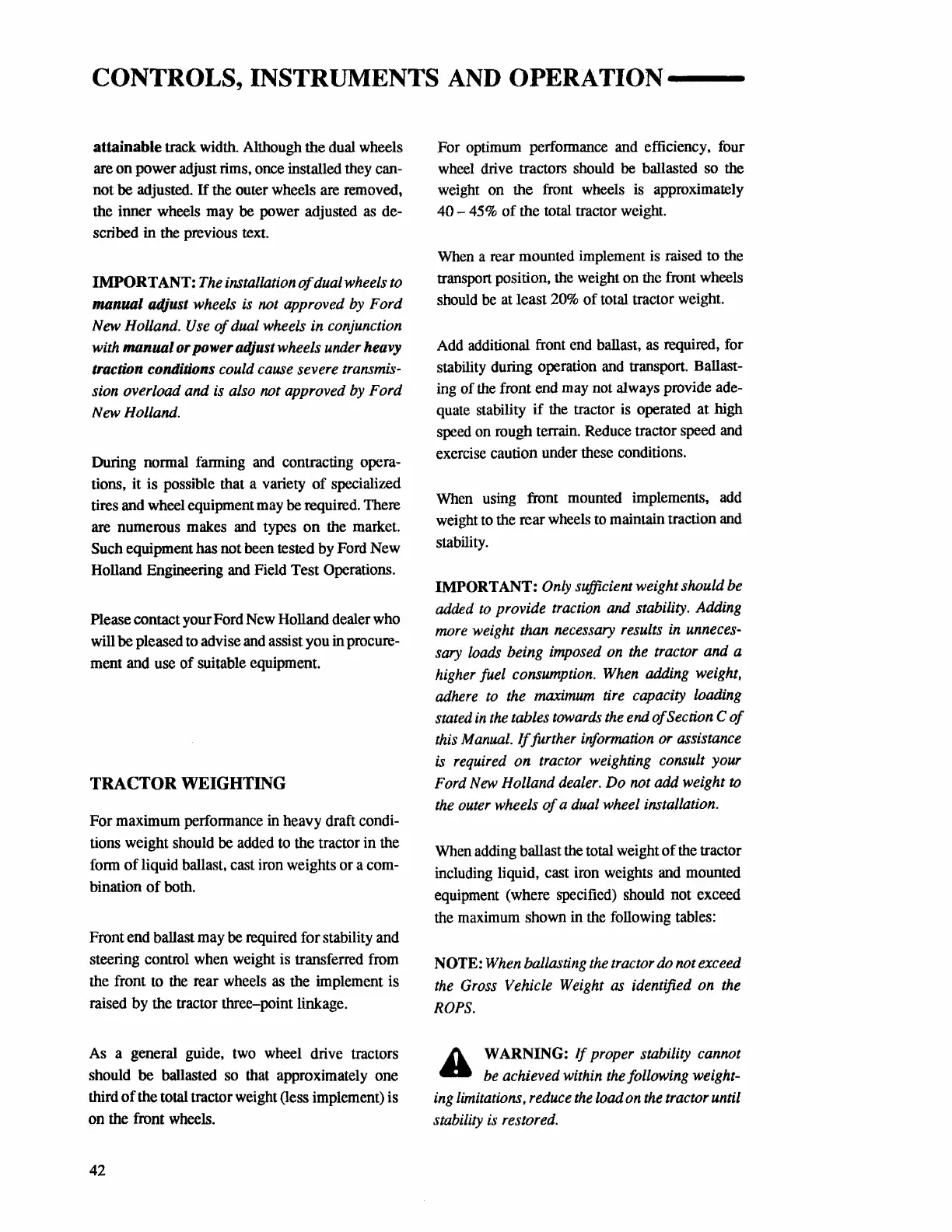CONTROLS, INSTRUMENTS
AND
OPERATION--
attainable track width. Although the dual wheels
are
on
power adjust rims, once installed they can-
not
be
adjusted.
If
the outer wheels are removed,
the inner wheels may
be power adjusted as de-
scribed in the previous text.
IMPORTANT:
The installation
of
dual wheels to
manual a4just wheels is not approved
by
Ford
New Holland.
Use
of
dual wheels in conjunction
with
manual or power adjust wheels under
heavy
traction conditions could cause severe transmis-
sion overload and is also not approved
by Ford
New Holland.
During normal fanning and contracting opera-
tions, it is possible that a variety
of
specialized
tires and wheel equipment may be required. There
are numerous makes and types
on
the market.
Such equipment has not been tested by Ford New
Holland Engineering and Field Test Operations.
Please contact your Ford New Holland dealer who
will
be
pleased to advise and assist you in procure-
ment and use
of
suitable equipment.
TRACTOR WEIGHTING
For maximum perfonnance in heavy draft condi-
tions weight should
be
added to the tractor in the
fonn
of
liquid ballast, cast iron weights
or
a com-
bination
of
both.
Front end ballast may
be
required for stability and
steering control when weight is transferred from
the front
to the rear wheels as the implement is
raised by the tractor three-point linkage.
As a general guide, two wheel drive tractors
should
be
ballasted so that approximately one
third
of
the total tractor weight (less implement) is
on
the front wheels.
42
For optimum perfonnance and efficiency, four
wheel drive tractors should
be ballasted so the
weight on the front wheels is approximately
40
- 45%
of
the total tractor weight.
When a rear mounted implement is raised to the
transport position, the weight on the front wheels
should
be
at least 20%
of
total tractor weight.
Add additional front end ballast, as required, for
stability during operation and transport. Ballast-
ing
of
the front end may not always provide ade-
quate stability
if
the tractor is operated at high
speed on rough terrain. Reduce tractor speed and
exercise caution under these conditions.
When using front mounted implements, add
weight to the rear wheels to maintain traction and
stability.
IMPORTANT: Only sufficient weight should be
added
to
provide traction
and
stability. Adding
more weight than necessary results in
unneces-
sary loads being imposed on the tractor and a
higher fuel consumption. When adding weight,
adhere to the maximum tire capacity loading
stated
in
the tables towards the end
of
Section C
of
this Manual.
If
farther information or assistance
is
required
on
tractor weighting consult your
Ford New Holland dealer. Do not add weight
to
the outer wheels
of
a dual wheel installation.
When adding ballast the total weight
of
the tractor
including liquid, cast iron weights and mounted
equipment (where specified) should not exceed
the maximum shown in the following tables:
NOTE: When ballasting the tractor do not exceed
the Gross
Vehicle Weight as identified
on
the
ROPS.
A WARNING:
If
proper stability cannot
4ll:a
be achieved within the following weight-
ing limitations, reduce the load on the tractor until
stability is restored.

